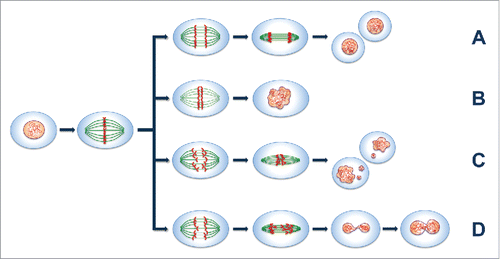At first glance mitosis and meiosis might appear to be very different processes, with one duplicating genetic material and the other reducing genetic material by half after genetic recombination and chromosome reshuffling.Citation1 However, mitosis and meiosis share a common event in which the chromosomes align on the metaphase plate and then segregate becoming equally distributed between the resulting daughter cells in mitosis or oocyte and polar body in meiosis.Citation1 This is because mitosis and meiosis are alternative programs responding to different selective needs that evolved from an eukaryote ancestor.Citation2 Regardless of whether chromosomal segregation occurs in somatic cells or germ cells, the chromosomes align along the metaphase plate/spindle apparatus and then faithfully segregate in order to avoid errors in mitosis or meiosis.Citation1
Numerous proteins interact with the metaphase plate and/or spindle apparatus and influence chromosomal segregation.Citation3 Of particular importance are proteins that localize to the mid-zone/mid-body of the spindle apparatus because these proteins ultimately control the final stages of mitosis and meiosis.Citation3 Interestingly, one protein that localizes to the mid-zone/mid-body is progesterone receptor membrane component-1 (PGRMC1).Citation4 This protein was initially identified in liver as a progesterone binding protein, which accounts for its name (For review see CahillCitation5). However, PGRMC1 is expressed in many cell types and has progesterone dependent and independent actions depending in part on its cellular location.Citation5 Although PGRMC1 is present at the mid-zone/mid-body of the spindle apparatus of both somatic and germ cells, the question arises as to whether PGRMC1 plays an essential role in the mechanism through which chromosomes segregate. This question was elegantly addressed in a paper from The Lodde Laboratory, which was recently published in Cell Cycle.Citation6
Lodde's group took advantage of the fact that PGRMC1 is expressed in both oocytes and somatic (ovarian granulosa) cells. To begin their investigations, PGRMC1 was initially depleted in bovine granulosa cells using an RNAi silencing approach. FACS analysis revealed that in the relative absence of PGRMC1 many cells arrested in the G2/M stage of the cell cycle. This study was followed by a series of time-lapse studies that demonstrate that while some PGRMC1-deplete cells apparently progress normally through mitosis (), others do not. Those with mitotic abnormalities have one of 3 fates: 1) cells undergo prophase/metaphase but do not progress beyond anaphase/telophase, reforming a single nucleus (); 2) cells progress through prophase/metaphase and form an aberrant nucleus with some genetic material excluded from the newly formed nucleus () or 3) cells undergo prophase/metaphase but DNA remains interconnected leading to incomplete karyokinesis (). Having visualized these events in granulosa cells, Lodde's group looked for evidence that similar abnormalities were occurring during meiosis in PGRMC1-depleted oocytes. These studies revealed that as with somatic cells, PGRMC1 was required for the precise and acute separation of the chromosomes and the extrusion of the polar body.
Figure 1. A diagrammatic representation of mitotic events in cells treated with PGRMC1 RNAi. While some cells appear to undergo mitosis normally (A), others enter into prophase/metaphase then either fail to progress beyond the anaphase/telophase, reforming a single nucleus (B) progress through the anaphase/telophase in an inappropriate manner that results in the formation of an aberrant nuclei from which small clumps of DNA are excluded (C) or progress through the mitotic cascade to karyokinesis but newly formed nuclei remain interconnected (D). In this diagram the cell is represented in blue, the mitotic spindle in green and the nuclei/chromosomes in red.

These pioneering studies dramatically demonstrate an important role for PGRMC1 in karyokinesis/cytokinesis. While PGRMC1's mechanism of action remains essentially unknown, Lodde's paper provides a hint as to PGRMC1's mode of action by demonstrating that PGRMC1 interacts with Aurora Kinase B (AURKB), an essential kinase that regulates the alignment and segregation of chromosomes in both mitosis and meiosis.Citation3 This interaction was revealed using an in situ proximity ligation assay, which allows for the identification of the precise cellular site at which specific proteins interact.Citation7 This approach demonstrated that PGRMC1: AURKB interaction is present throughout mitosis but dramatically increases at the mid-zone/mid-body at telophase. Therefore, by identifying the mid-zone/mid-body as a specific site where PGRMC1: AURKB interaction occurs, these seminal studies provide the basis for future investigation. Hopefully, these future research efforts will ultimately reveal the precise mechanism through which PGRMC1 affects specific protein interactions at the mid-zone/mid-body that result in the faithful separation of chromosomes, thereby preventing errors in mitosis and meiosis.
Disclosure of potential conflicts of interest
No potential conflicts of interest were disclosed.
References
- Duro E, Marston AL. From equator to pole: splitting chromosomes in mitosis and meiosis. Genes Dev 2015; 29(2):109-22; PMID:25593304; http://dx.doi.org/10.1101/gad.255554.114
- Markov AV, Kaznacheev IS. Evolutionary consequences of polyploidy in prokaryotes and the origin of mitosis and meiosis. Biol Direct 2016; 11:28; PMID:27277956; http://dx.doi.org/10.1186/s13062-016-0131-8
- Kitagawa M, Lee SH. The chromosomal passenger complex (CPC) as a key orchestrator of orderly mitotic exit and cytokinesis. Front Cell Dev Biol 2015; 3:14; PMID:25798441; http://dx.doi.org/10.3389/fcell.2015.00014
- Bonner MK, et al. Mitotic spindle proteomics in Chinese hamster ovary cells. PloS One 2011; 6(5):e20489; PMID:21647379; http://dx.doi.org/10.1371/journal.pone.0020489
- Cahill MA. Progesterone receptor membrane component 1: an integrative review. J Steroid Biochem Mol Biol 2007; 105(1–5):16-36; PMID:17583495; http://dx.doi.org/10.1016/j.jsbmb.2007.02.002
- Terzaghi L, et al. PGRMC1 participates in late events of bovine granulosa cells mitosis and oocyte meiosis. Cell Cycle 2016; 15(15): 2019-32; PMID: 27260975; http://dx.doi.org/10.1080/15384101.2016.1192731
- Soderberg O, et al. Characterizing proteins and their interactions in cells and tissues using the in situ proximity ligation assay. Methods 2008; 45(3):227-32; PMID:18620061; http://dx.doi.org/10.1016/j.ymeth.2008.06.014
